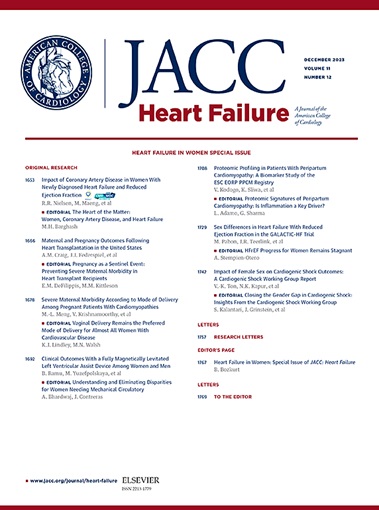充血和低心输出量血流动力学表型驱动超重和肥胖HFpEF的结局。
IF 11.8
1区 医学
Q1 CARDIAC & CARDIOVASCULAR SYSTEMS
引用次数: 0
摘要
背景:迄今为止,超重和肥胖心力衰竭患者保留射血分数(HFpEF)的充血和灌注的血流动力学评估,以及各自的血流动力学表型对临床结果的影响有限。目的:作者通过充血和灌注状态的血流动力学评估来确定超重和肥胖HFpEF患者的主要特征,并将这些血流动力学表型与临床结果相关联。方法纳入约翰霍普金斯HFpEF诊所符合HFpEF临床标准并进行右心导管评估的227例患者。血流动力学组分为:干温组(肺毛细血管楔压[PCWP] 2.2 L/min/m2)、湿温组(PCWP≥15mm Hg,心脏指数>2.2 L/min/m2)、干冷组(PCWP < 15mm Hg,心脏指数≤2.2 L/min/m2)、湿冷组(PCWP≥15mm Hg,心脏指数≤2.2 L/min/m2)。结果与“暖型”患者相比,“冷型”(干冷+湿冷)HFpEF患者占队列的34%,且更可能是老年人(冷型:68±11岁vs暖型:62±12岁,P = 0.002)、男性(冷型:51% vs暖型66%,P = 0.04)、房颤(P = 0.0007)、n端前b型利钠肽较高(P = 0.03)、肺血管阻力指数较高。在4个血流动力学组中,湿冷患者的n端前b型利钠肽水平最高(469 pg/mL [Q1-Q3: 257- 1389 pg/mL];总体P = 0.0001),房颤发生率最高(54%,总体P = 0.001),并且更有可能接受β受体阻滞剂治疗(68%,P = 0.05)。Kaplan-Meier生存分析(中位随访时间:39个月)显示,低心脏灌注(热稀释法和菲克法)的HFpEF患者即使在考虑了体重指数可能的过度校正后,死亡率也更低。结论在符合临床HFpEF标准诊断标准的以超重和肥胖为主的HFpEF队列中,34%的患者在血流动力学测试中出现心脏指数下降。血流动力学评估可能会在HFpEF中发现一种未被充分认识的低输出血流动力学表型,这种表型与充血相结合,与较差的临床结果相关。本文章由计算机程序翻译,如有差异,请以英文原文为准。
Congestion and Low Cardiac Output Hemodynamic Phenotype Drives Outcomes in Overweight and Obese HFpEF
Background
Hemodynamic assessment of congestion and perfusion in overweight and obese patients with heart failure with preserved ejection fraction (HFpEF), and the respective impact of hemodynamic phenotypes on clinical outcomes has been limited to date.
Objectives
The authors characterized predominantly overweight and obese HFpEF patients by hemodynamic assessment of congestion and perfusion status and correlated these hemodynamic phenotypes with clinical outcomes.
Methods
A total of 227 patients referred to the Johns Hopkins HFpEF Clinic meeting clinical criteria for HFpEF and with right heart catheterization assessment were included. Hemodynamic-based groups were assigned as follows: dry-warm (pulmonary capillary wedge pressure [PCWP] <15 mm Hg, cardiac index >2.2 L/min/m2), wet-warm (PCWP ≥15 mm Hg, cardiac index >2.2 L/min/m2), dry-cold (PCWP <15 mm Hg, cardiac index ≤2.2 L/min/m2), and wet-cold (PCWP ≥15 mm Hg, cardiac index ≤2.2 L/min/m2).
Results
Compared to “warm” profile patients, HFpEF subjects classified as “cold” profile (dry-cold + wet-cold) accounted for 34% of the cohort and were more likely to be older (cold: 68 ± 11 years vs warm: 62 ± 12 years; P = 0.002), male (cold: 51% vs warm 66%; P = 0.04), have atrial fibrillation (P = 0.0007), with higher N-terminal pro–B-type natriuretic peptide (P = 0.03), and higher pulmonary vascular resistance indices. Of the 4 hemodynamic groups, wet-cold patients had the highest N-terminal pro–B-type natriuretic peptide levels (469 pg/mL [Q1-Q3: 257-1,389 pg/mL]; overall P = 0.0001), highest rate of atrial fibrillation (54%, overall P = 0.001), and were more likely to be on beta-blocker therapy (68%; P = 0.05). Kaplan-Meier survival analysis (median follow-up time: 39 months) revealed that HFpEF patients with low cardiac perfusion (thermodilution method and Fick method) had worse mortality even after accounting for potential overcorrection from body mass index.
Conclusions
In a predominantly overweight and obese HFpEF cohort meeting standard diagnostic criteria for clinical HFpEF, 34% had a depressed cardiac index on hemodynamic testing. Hemodynamic assessment may identify an under-recognized low-output hemodynamic phenotype in HFpEF, which in combination with congestion, is associated with worse clinical outcomes.
求助全文
通过发布文献求助,成功后即可免费获取论文全文。
去求助
来源期刊

JACC. Heart failure
CARDIAC & CARDIOVASCULAR SYSTEMS-
CiteScore
21.20
自引率
2.30%
发文量
164
期刊介绍:
JACC: Heart Failure publishes crucial findings on the pathophysiology, diagnosis, treatment, and care of heart failure patients. The goal is to enhance understanding through timely scientific communication on disease, clinical trials, outcomes, and therapeutic advances. The Journal fosters interdisciplinary connections with neuroscience, pulmonary medicine, nephrology, electrophysiology, and surgery related to heart failure. It also covers articles on pharmacogenetics, biomarkers, and metabolomics.
 求助内容:
求助内容: 应助结果提醒方式:
应助结果提醒方式:


